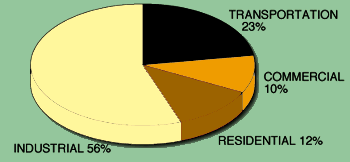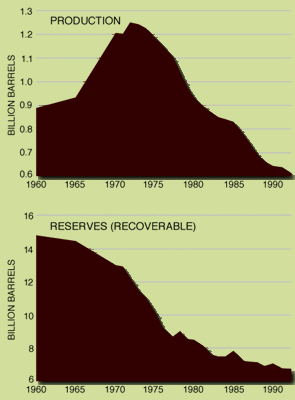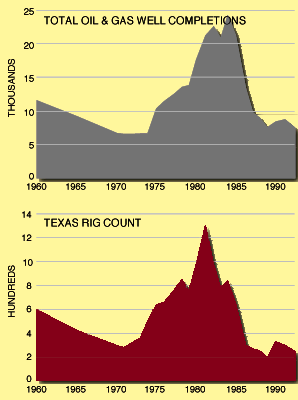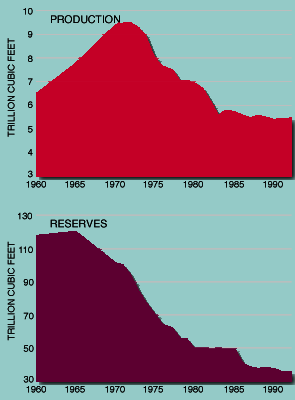

Almanac Table of Contents | Chapter Seven Table of Contents | TEC Home Page
NEXT PAGE * PREVIOUS PAGE Go to page 1*2*3*4*5*Notes

Texas has been producing oil for more than 110 years. Ever since the first wells in Brown County began producing oil for medicinal purposes and lubrication, oil has been a precious commodity.(23)
More than a quarter of all the known oil deposits in the U.S. are in Texas.(24) Yet, less than a third of the 190 billion barrels of oil beneath Texas have been produced. Some 129 billion barrels of oil remain, but much of that oils lies deep beneath the surface, making production difficult and expensive.(25)
Texas has the largest share of crude oil reserves in the nation. And the state's oil has provided a reliable source of tax revenue. Since 1930, Texas has collected more than $17 trillion in oil taxes.(26) The state's oil reserves have also spawned a vast refining and petrochemical industry; two-thirds of America's petrochemical production occurs in Texas.(27)
Twenty-three percent of all the oil produced in the U.S. comes from Texas fields.(28) Much of the oil produced in Texas comes from older wells with declining production. These so-called "stripper" wells produce 10 barrels of oil or less per day. But they are critically important to the state's economy because they are so numerous. In 1992, 70 percent of the 192,292 oil wells in Texas were stripper wells.(29) Because stripper wells produce little oil and cost more to operate than other wells, producers and regulators have argued that tax incentives are needed to keep these wells in operation. The average daily production per Texas oil well is fewer than nine barrels. By contrast, the average oil well in Saudi Arabia produces about 6,000 barrels per day.(30)
Oil production in the state peaked in 1972 at 3.4 million barrels per day. Twenty years later, production had fallen by more than half, to 1.68 million barrels per day. This drop in production has forced the country to rely more on imported oil.
Ever since the Organization of Petroleum Exporting Countries shocked the world in the late 1970s by raising prices, Americans have worried about the consequences of relying on imported oil. However, this concern has faded as oil prices have fallen. At present, half of all the oil consumed in the U.S. is imported.(31) By the year 2010, the U.S. could be importing 70 percent of its oil.(32) This increasing reliance on imported oil could have dire consequences for America. As demonstrated by the Persian Gulf War, protecting foreign oil supplies in the Mideast and elsewhere is a costly undertaking and success is not guaranteed. Texas oil producers have long argued that stimulating the domestic oil business would have lasting benefits for the domestic economy. They advocate tax incentives to encourage oil producers to drill new wells and bring marginal wells back into production.
Texas oil producers face increased costs of environmental compliance. The American Petroleum Institute estimates that the oil industry will be spending $20 billion per year on environmental compliance by the year 2000, an increase of 250 percent over 1992.(33) Environmental costs and declining domestic oil reserves have forced American oil producers and multi-national oil companies to go overseas to develop new sources of petroleum. In 1985, the major oil companies spent 37 percent of their exploration dollars outside of the U.S. By 1991, that figure had nearly doubled.(34)
Beyond use of oil as fuel, oil exploration and production itself can have serious potential environmental consequences. For example, the Railroad Commission of Texas must deal with thousands of abandoned oil wells. Unplugged and abandoned oil wells can cause serious groundwater contamination problems, particularly in areas with naturally occurring saline groundwater. Unplugged or improperly plugged wells are vertical pipelines that can allow deep brine water reservoirs to contaminate shallow fresh water aquifers. And in many areas around the state, rural residents have been forced to abandon their water wells due to salt water contamination caused by abandoned oil wells or unlined saltwater disposal pits.(35) By plugging wells as required by Railroad Commission of Texas regulations, oil producers can prevent the migration of saline water from deep aquifers into shallow fresh water aquifers.
Some surface water supplies are also threatened by unplugged wells. Two studies by the Lower Colorado River Authority found that saltwater from unplugged oil wells along the river are causing an increase in salinity levels.(36) About 1.5 million oil wells have been drilled in Texas, yet less than a third of them have been plugged.(37)
In addition, hundreds of production sites, littered with abandoned tanks, spilled oil, drilling pads and oilfield equipment await remediation and cleanup. (See Water Section). Using money from a surcharge on new drilling permits, the agency has plugged several thousand abandoned wells and cleaned up a number of abandoned production sites.(38) However, this effort is just beginning and it could take many decades to clear up problems caused by past negligence or lack of enforcement.
Source: Central Power & Light, Watts New, March 1994, 3.

Source: Department of Energy, State Energy Data Report, 1992

Source: Railroad Commission of Texas, Texas Oil and Gas Notes, Sept. 1993.

Source: Railroad Commission of Texas, Texas Oil and Gas Notes, Sept. 1993.
Natural gas was once considered a useless waste product of the oil production process. Oil producers burned off this gas or vented it into the atmosphere in order to dispose of it. Today, some energy analysts are calling natural gas the "prince of the hydrocarbons."(39)
Texas consumes more natural gas than any other state.(40) In 1993, Texas consumed 3.4 trillion cubic feet (Tcf), almost twice as much as California, the number two consumer.(41) Texas produces about 5.5 Tcf of gas every year, which accounts for 25 percent of total U.S. domestic gas production. The state has about 36 trillion cubic feet of gas reserves, or about one-quarter of total U. S. domestic gas reserves.(42) This wealth of natural gas has contributed nearly $15 trillion in tax revenue to state coffers since 1930.(43)
Natural gas is becoming increasingly important as a source of revenue. From 1985 through 1990, Texas collected more tax revenue from natural gas than from oil.(44)
New uses for natural gas are causing consumption to increase. The fuel can now be used to power air conditioners and is gaining popularity in the transportation sector. Compressed natural gas (CNG) and liquified natural gas (LNG) offer clean-burning alternatives to fleet owners, who must convert large portions of their vehicles to alternative fuels in order to comply with Clean Air Act regulations. Natural gas is also being used more by utilities for power generation.
While new uses for gas may help the state over the long term, Texas is depleting its natural gas reserves faster than those reserves are being replaced by new discoveries.(45) Since 1965, the state's gas reserves have been steadily decreasing.(46)
In 1981, Texas energy producers brought 5,454 natural gas wells into service. By 1991, the number of gas wells brought on-line had fallen to 1,471.(47) This decline in exploration could have negative long-term effects on Texas, which continues to need vast amounts of natural gas for residential, commercial and industrial uses.

Source: Railroad Commission of Texas, Texas Oil and Gas Notes, Sept. 1993.
Most consumers know LPG as butane or propane. These liquids are removed from oil and gas during the refining process. A flexible fuel, LPG can be used for everything from burning weeds to powering farm tractors. Propane is second only to natural gas in terms of heat content. One-third of the nation's propane is produced in Texas.(48)
New concerns about clean air will also likely stimulate consumption of LPG in Texas. Texas used 12.2 billion gallons of LPG in 1990, most of which was consumed by the petrochemical industry.(49) LPG also plays an important role in rural areas, which often do not have natural gas lines. Millions of rural Texans rely on propane and butane for cooking and water heating. In the commercial sector, LPG powers forklifts and other industrial equipment. The market for LPG will likely be stimulated by its increased use as a motor vehicle fuel.
By 2002, federal law will require about one million vehicles in Texas to be fueled by alternative fuels like propane or natural gas.(50) (See Air Section for further discussion.) Propane will likely be the fuel of choice for many operators because converting vehicles to LPG costs about half as much as converting to compressed natural gas (CNG). In addition, LPG-powered vehicles can travel much farther between fueling stops than comparable CNG-powered vehicles. Thus far, nine out of ten Texas school buses that have converted to alternative fuels have switched to propane.(51) In all, more than 30,000 propane-fueled vehicles are in use in Texas, with some 1,200 propane dealers providing refueling services.(52) This network of refueling centers gives propane-powered vehicles another advantage over CNG. Only a handful of refueling stations in Texas supply CNG to the public.
With its flexibility and availability, LPG will continue to be a major energy source for many years to come.
| REPRESENTATIVE HEATING VALUES FOR COMMON FUELS | |
|---|---|
| FUEL | BTU/LB |
| Natural Gas | 24,000 |
| Propane | 21,500 |
| Butane | 21,180 |
| #2 Fuel Oil | 20,000 |
| #6 Fuel Oil | 19,000 |
| Gasoline | 19,000 |
| Coal | |
| Anthracite | 12,700 |
| Sub-bituminous | 9,000 |
| Lignite | 6,300 |
| Note: One Btu (British Thermal Unit) equals the heat required to raise the temperature of one pound of water by one degree Fahrenheit. | |
| Source: Bruce Hunn, University of Texas at Austin, Center for Energy Studies | |

NEXT PAGE * PREVIOUS PAGE Go to page 1*2*3*4*5*Notes

Please send questions, comments, or problems with this page to ltarver@mail.utexas.edu.